When crafting natural perfumes, you'll want to match top notes with each season's character. Choose bright citrus and delicate florals for spring, marine and zesty combinations for summer, warm spices like cinnamon for autumn, and crisp pine with cardamom for winter. Your body chemistry and local climate will affect how these notes perform. Understanding seasonal dynamics helps you create perfectly balanced fragrances that evolve beautifully throughout the year.
Understanding the Role of Top Notes in Natural Perfumery
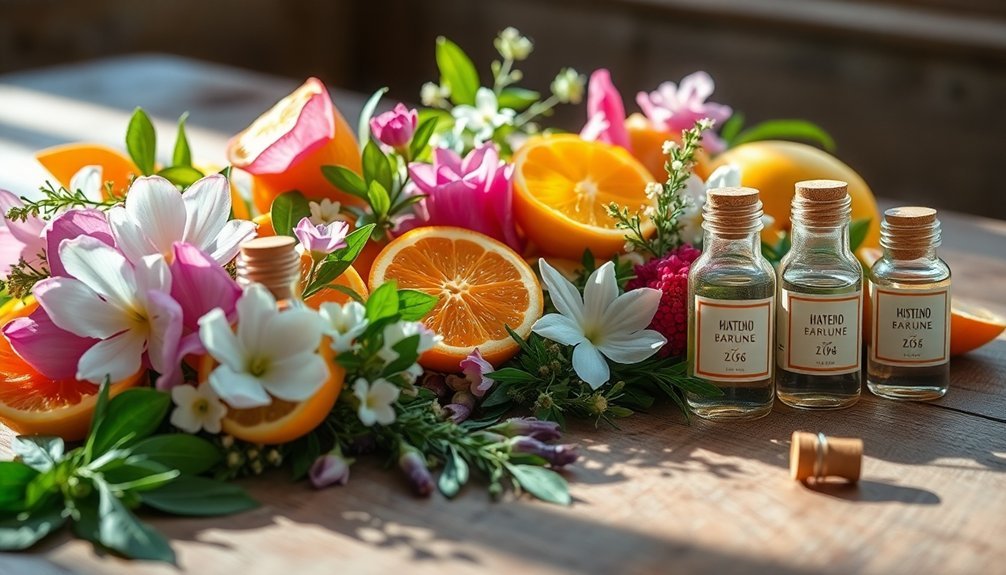
When you first apply a natural perfume, top notes immediately captivate your senses and create that essential first impression.
In natural perfumery, these initial scents play a vital role in setting the mood and tone of your fragrance experience. You'll notice how citrus, herbs, and delicate florals dance together, offering a vibrant introduction to the scent's story.
Your body chemistry greatly influences how these top notes perform, making each fragrance uniquely yours.
As the most volatile components, they'll evolve differently depending on your skin and the environment around you. When selecting a seasonal fragrance, you'll want to reflect on how these fleeting notes complement the weather and occasion.
Understanding top notes helps you appreciate how they beautifully shift into the heart and base notes that follow.
The Science Behind Seasonal Fragrance Changes
As temperatures fluctuate throughout the year, your favorite fragrances respond dramatically to these seasonal shifts.
The science behind seasonal fragrance changes reveals how environmental factors greatly impact your natural perfume experience. In warmer weather, you'll notice:
- Top notes become more volatile and pronounced, creating a stronger initial burst
- Humidity amplifies sweet and floral elements, making them more prominent
- Dry air enhances the clarity and intensity of scent profiles
Your fragrance perception varies with skin chemistry and temperature interactions.
During summer, you'll experience more projection and sillage from your perfume's top notes, while winter's cold air subdues these effects.
Understanding these seasonal dynamics helps you adapt your fragrance choices, ensuring the best expression as environmental conditions change throughout the year.
Essential Spring Top Notes: Fresh and Floral Selections
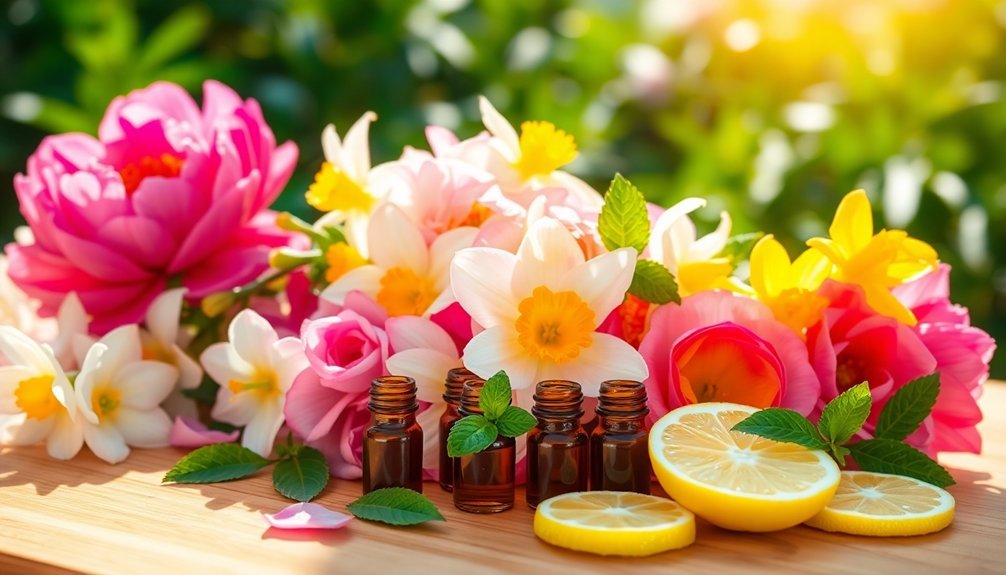
Spring's vibrant awakening calls for five essential top notes that capture the season's renewal and freshness. You'll find natural scents like mint and bergamot delivering an invigorating burst, while floral elements such as Lily of the Valley create an airy, garden-like atmosphere. To complement these fresh notes, you'll want to incorporate herbal components like juniper berry and rosemary.
| Fresh Notes | Floral Notes |
|---|---|
| Lemon | Narcissus |
| Bergamot | Lily Valley |
| Fresh Grass | Spring Herbs |
These spring top notes evaporate quickly in warmer temperatures, making them perfect for the season's changing climate. The combination of citrus, herbs, and florals creates a well-balanced profile that mirrors nature's springtime revival, offering you an authentic and uplifting fragrance experience.
Summer's Vibrant Top Notes: Citrus and Marine Aromas
Summer's sun-drenched days demand vibrant top notes that capture the season's energetic spirit. When selecting natural perfumes for the warmest months, you'll want to focus on citrus and marine notes that provide an immediate burst of rejuvenation.
These summer fragrances create the perfect balance between invigorating and revitalizing scents.
You'll discover vibrant top notes that:
- Transport you to sun-soaked shores with marine notes of sea salt and ocean breeze
- Energize your senses with zesty combinations of lemon, lime, and bergamot
- Complement outdoor activities with quick-evaporating, invigorating bursts
The harmonious blend of citrus and aquatic elements mirrors nature's summer vibrancy, making these scents ideal for your warm-weather adventures.
They'll provide the perfect amount of projection while maintaining a light, breezy character that won't overwhelm in the heat.
Autumn's Warm Top Notes: Spice and Wood Elements
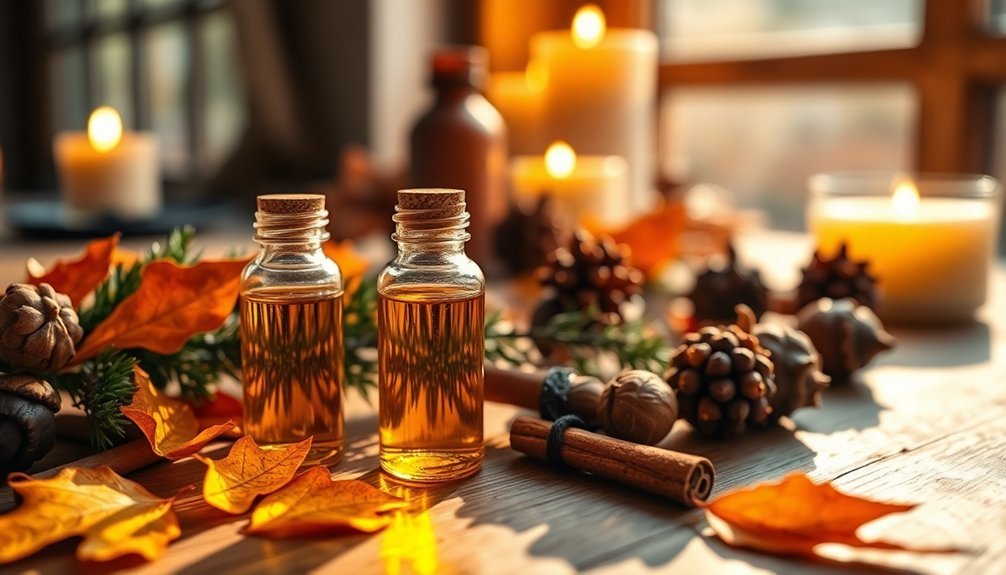
You'll find the perfect autumn fragrance by exploring the harmonious blend of cinnamon and clove, which creates a warm, inviting aroma that mirrors the season's cozy atmosphere.
These spicy top notes pair beautifully with crisp forest pine elements, offering a natural shift from summer's lighter scents.
The combination captures both the comfort of seasonal spices and the invigorating freshness of autumn woodlands, making it an ideal choice for your fall fragrance wardrobe.
Cinnamon and Clove Harmony
When autumn arrives, cinnamon and clove emerge as the quintessential top notes that capture the season's cozy essence.
These warm spices create an inviting blend in natural perfumes, where their complementary qualities enhance the depth and richness of autumn fragrances.
You'll find their harmonious combination particularly effective when paired with woody base notes like sandalwood and cedar.
The magical pairing of cinnamon and clove can transport you to familiar seasonal moments:
- Fresh-baked treats wafting from your grandmother's kitchen
- Steaming cups of spiced cider on crisp evenings
- Holiday gatherings filled with warmth and laughter
When you're selecting your next autumn fragrance, look for these spice notes at the top of the blend.
They'll provide that perfect balance of sweet, woody, and slightly bitter elements that define the season.
Crisp Forest Pine Notes
Forest trails come alive in autumn fragrances through the addition of crisp pine notes, offering a revitalizing counterpoint to warmer spice elements.
When you're crafting your natural perfume, you'll find that crisp forest pine notes create an authentic outdoor experience that grounds your blend in nature's essence.
You'll discover that pine's clean, fresh profile works beautifully with woody notes and resinous ingredients, while complementing seasonal spices like cinnamon and nutmeg.
These natural ingredients help you build emotional connections to autumn's changing landscape, evoking memories of crisp morning walks and peaceful forest settings.
Winter's Comforting Top Notes: Rich and Deep Choices
You'll discover that winter's top notes excel when combining spicy cardamom with sweet vanilla undertones, creating an instant feeling of warmth and protection from the cold.
Your fragrance choices during winter can embrace this powerful duo, where cardamom's exotic spiciness mingles perfectly with vanilla's familiar comfort.
These complementary notes work together to wrap you in a cozy sensory experience that's perfectly suited for the season's chilly temperatures.
Spicy Cardamom Warmth
Among winter's most enchanting fragrance elements, cardamom stands out as a spicy top note that infuses perfumes with irresistible warmth and depth.
When you're selecting winter fragrances, you'll find this aromatic spice perfectly complements other spicy notes while creating harmonious blends with base notes like vanilla and amber.
Cardamom's unique character evokes:
- Cozy gatherings around a crackling fireplace
- Festive holiday memories with family and friends
- Warm, spiced beverages on chilly winter evenings
You'll discover that cardamom-infused perfumes capture winter's essence through their rich, comforting profiles.
This versatile ingredient works beautifully alongside cinnamon and nutmeg, creating sophisticated seasonal fragrances that'll transport you to a world of warmth and nostalgia during the coldest months of the year.
Sweet Vanilla Comfort
While cardamom brings spicy warmth to winter fragrances, sweet vanilla emerges as another enchanting top note choice for the season. You'll find this versatile ingredient creating a cozy atmosphere in winter perfumes, especially when paired with rich amber or decadent cocoa notes. The resulting fragrance profile transports you to festive moments while complementing your winter wardrobe.
| Emotion | Vanilla Pairing |
|---|---|
| Nostalgic | Caramel |
| Luxurious | Amber |
| Festive | Cinnamon |
| Comforting | Nutmeg |
When selecting gourmand fragrances for winter, consider how sweet vanilla layers beautifully with spicy notes, making it perfect for both day and evening wear. Its warm, inviting nature wraps you in comfort while maintaining sophistication, proving essential for your cold-weather fragrance collection.
Blending Techniques for Seasonal Top Notes
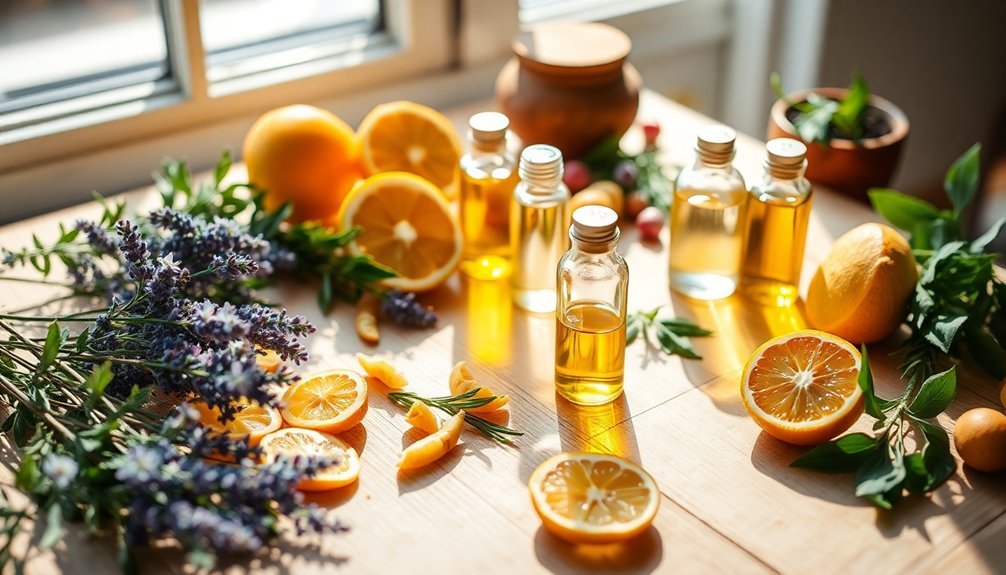
Creating a balanced seasonal fragrance starts with mastering the art of blending top notes. When you're developing your fragrance collection, begin by layering lighter, volatile scents before incorporating deeper elements.
The key is understanding how natural ingredients interact and evolve on your skin.
For ideal seasonal blending techniques, consider these sensory combinations:
- Spring/Summer: Pair fresh citrus top notes like bergamot with delicate floral notes of jasmine or gardenia
- Autumn: Layer warm spices such as cinnamon with earthy undertones
- Winter: Combine crisp juniper with rich woody notes for depth
Remember that your top notes set the tone for the entire fragrance experience.
Natural Ingredients for Creating Signature Seasonal Scents
When you're crafting signature seasonal scents, you'll want to start with careful botanical extraction methods that preserve the natural volatility of your chosen top notes.
Your raw material sourcing should follow seasonal patterns, selecting fresh citrus oils for spring blends, ripe fruit essences for summer, warm spices for autumn, and rich aromatics for winter compositions.
Blending these natural ingredients requires a strategic approach to essential oil bases, ensuring your top notes properly complement the season while maintaining their distinctive opening characteristics.
Seasonal Botanical Extraction Methods
The art of extracting seasonal botanicals demands specific techniques to capture each ingredient's authentic essence.
You'll find that different methods create unique fragrances for each season, from summer's vibrant citrus to winter's deep spices. Through steam distillation, cold pressing, and solvent extraction, you're able to preserve the most delicate floral fragrances while ensuring fragrances with nuances remain intact.
- Steam distillation gently coaxes essential oils from spring flowers and summer herbs
- Cold pressing extracts bright citrus oils from fresh peels, perfect for sunny seasons
- Solvent extraction carefully preserves complex winter and autumn aromas
When sourcing your seasonal ingredients, remember that sustainable sourcing practices are vital.
You'll want to work with suppliers who harvest responsibly and support local communities, ensuring these precious botanicals remain available for future generations.
Raw Material Sourcing Guide
Successful seasonal perfume creation hinges on sourcing high-quality natural ingredients that capture each season's distinct character.
When selecting raw materials for your natural perfumes, focus on organic, ethically sourced botanicals that align with your target season's fragrance characteristics.
For spring blends, you'll want to source fresh citrus essential oils like bergamot and lime, paired with seasonal flowers such as lily of the valley.
Summer compositions benefit from mint, rosemary, and jasmine notes, while autumn scents require warm spices like cinnamon.
Pay close attention to each ingredient's growing conditions and ideal harvest times to guarantee maximum potency in your final creation.
Blending Essential Oil Bases
Creating signature seasonal scents begins with mastering the art of essential oil blending.
You'll want to select complementary notes that capture each season's distinct characteristics while ensuring your fragrances remain balanced and harmonious.
- Spring/Summer: Start with bright, citrusy top notes like bergamot and lemon, perfectly matched with mint for a revitalizing blend.
- Fall: Combine warm spices such as cinnamon and nutmeg with deeper base notes like sandalwood.
- Winter: Layer rich, comforting notes of clove with vanilla to create cozy seasonal atmosphere.
To develop your signature scent, experiment with different combinations of these seasonal notes.
Remember that base notes serve as the foundation that anchors your blend, while top notes deliver the immediate seasonal impression you're seeking to achieve.
Balancing Top Notes With Heart and Base Notes
When crafting a balanced fragrance, understanding how top notes interact with heart and base notes becomes essential for achieving a harmonious scent profile.
You'll need to reflect on how your chosen top notes, which create that initial seasonal freshness, will blend seamlessly with the more enduring heart notes that define your fragrance's character.
Pay attention to fragrance evolution as your scent develops on the skin. Your top notes might feature bright citrus for spring and summer, or warming spices for autumn and winter.
These should flow smoothly into your heart notes while being anchored by lasting base notes. Remember that environmental factors like temperature and humidity will affect how your notes interact and project.
The key is creating a layered composition where each note complements the others throughout the wearing experience.
Storage and Preservation of Seasonal Natural Perfumes
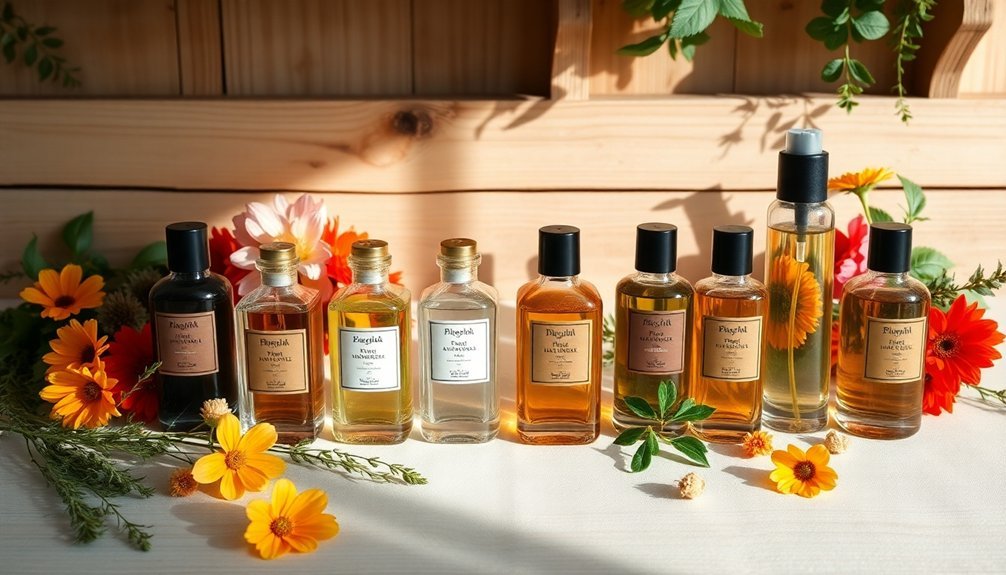
Proper storage methods play an essential role in preserving your seasonal natural perfumes' delicate compositions. To maintain the integrity of fragrance compounds, you'll need to store your natural perfumes in a cool, dry environment away from direct sunlight.
Use dark or opaque glass containers with tight-fitting caps to protect against light exposure and oxidation.
Your storage location should reflect these essential conditions:
- A dedicated drawer or cabinet in a temperature-controlled room
- A dark wooden box placed in a closet away from heat sources
- A specialized perfume storage case with UV protection
Remember that natural perfumes have a shorter shelf life than synthetic ones, typically lasting 1-3 years with proper preservation.
Don't store them in humid bathrooms, and regularly check for any changes in scent or consistency.
Testing and Adjusting Seasonal Top Note Combinations
Successfully testing seasonal top note combinations requires a methodical approach to fragrance evaluation and adjustment. You'll need to experiment with different blends on blotter strips or skin, as fragrances smell different depending on environmental conditions. Each season is one factor that greatly influences how scents project and develop.
| Season | Ideal Top Notes | Testing Tips |
|---|---|---|
| Spring/Summer | Bergamot, Mint | Test in warm weather |
| Fall/Winter | Cinnamon, Clove | Test in cool conditions |
| Shift | Citrus, Herbs | Test at varying temps |
Track your observations to refine the overall composition of your seasonal fragrances. When layering notes, consider how they interact and evolve over time. Temperature and humidity will affect your scent's performance, so test under various conditions to confirm your chosen combination maintains its intended character throughout wear.
Frequently Asked Questions
Can Pregnant Women Safely Use Natural Seasonal Perfumes?
You'll want to consult your doctor before using any perfumes during pregnancy. While natural fragrances may seem safer, some essential oils can affect pregnancy. It's best to err on the side of caution.
How Long Does It Take to Develop a Nose for Perfumery?
You'll need about 2-3 years of consistent practice to develop a trained nose for perfumery. Start by learning basic scents, keeping a fragrance journal, and regularly testing your ability to identify notes.
Why Do Some Seasonal Scents Trigger Headaches or Allergies?
You'll get headaches from seasonal scents when they're too concentrated or contain synthetic chemicals that irritate your sinuses. Some people are also naturally sensitive to specific fragrance compounds or essential oils.
Are Natural Perfumes More Expensive Than Synthetic Ones?
You'll typically find natural perfumes cost more than synthetic ones because they require larger quantities of raw materials, complex extraction processes, and rare ingredients. However, they often offer unique, authentic aromatic experiences.
Can I Mix Top Notes From Different Seasons Together?
You can definitely mix top notes from different seasons! While some scents naturally complement each other better, there's no rule against experimenting. Just trust your nose and create combinations that you personally enjoy.
In Summary
By mastering seasonal top notes in natural perfumery, you'll create fragrances that perfectly match each time of year. Remember to test your combinations thoroughly, store your blends properly, and adjust based on personal preferences and seasonal changes. As you continue experimenting with different natural ingredients, you'll develop a keen sense for which top notes work best together and how they'll complement your base and heart notes.

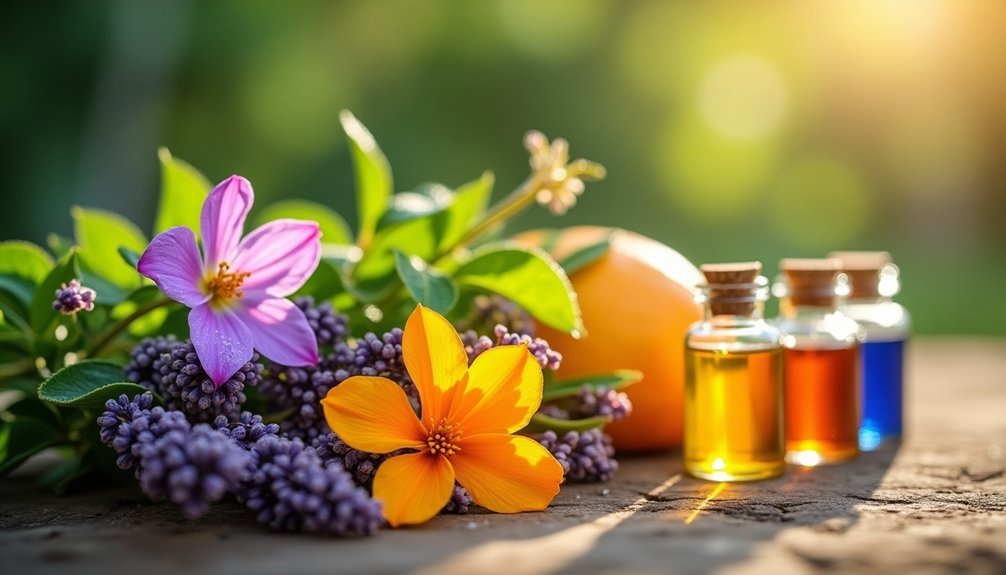



Leave a Reply